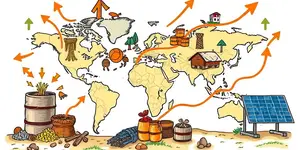
In an age of instant global connectivity, the foreign exchange market operates at the heart of international commerce. This article unpacks the essentials of Forex, providing readers with the clarity and confidence to navigate this dynamic financial playground.
The Forex (foreign exchange) market serves as the global platform for buying, selling, and exchanging currencies. Every trade involves two currencies—one you buy and one you sell. For example, EUR/USD represents the euro as the base currency and the US dollar as the quote currency.
The Forex market is the largest financial market globally, with over $7.5 trillion traded daily in 2025. Its immense scale eclipses other markets and facilitates every cross-border transaction, from corporate imports to individual travel expenses.
Trading in Forex runs 24 hours a day, five days a week, spanning major financial hubs: London, New York, Tokyo, Singapore, and Hong Kong. When one market closes, another opens, providing uninterrupted liquidity.
Transactions occur in various forms—spot, futures, swaps, and forwards. Traders choose from standardized lot sizes: micro (1,000 units), mini (10,000 units), and standard (100,000 units). This flexibility empowers both small-scale retail investors and massive institutions.
Over the past decade, the Forex market has seen average daily trading volume exceeds $7.5 trillion, a testament to its vitality. Market analysts project annual growth from USD 861 billion in 2024 to USD 1,535 billion by 2033, reflecting a 6.64% CAGR.
This growth is propelled by urbanization, digitalization, and round-the-clock trading opportunities. As fintech and AI solutions mature, forecasting precision and trade execution speed will only intensify.
Demographics reveal a shifting landscape: the 18–35 age group dominates trading activity, while female participation steadily gains momentum. Social media platforms and community forums play pivotal roles in shaping retail sentiment.
AI-powered analysis tools and algorithmic strategies are redefining decision-making, allowing traders to process vast datasets in real time. Meanwhile, digital wallets and blockchain innovations hint at future trading paradigms.
Geopolitical factors—trade policies, tariffs, and global conflicts—inject volatility. For instance, potential U.S. tariffs on imports from China, Mexico, and Canada can sway currency valuations overnight.
Central bank policies and interest rate differentials remain foundational drivers. A nation raising rates often attracts foreign capital, strengthening its currency, while dovish stances can trigger depreciation.
Regulatory frameworks vary globally, influencing leverage limits, capital requirements, and reporting standards. Traders must stay informed of local rules to avoid compliance pitfalls.
Successful Forex trading hinges on a clear plan that blends technical analysis with fundamental insights. Chart patterns, moving averages, and oscillators provide visual cues, while economic indicators—GDP, employment data, and inflation rates—ground decisions in real-world trends.
Emotional discipline is equally critical. A structured risk-reward ratio, combined with stop-loss and take-profit orders, helps contain losses and lock in gains.
The Forex market’s sheer scale and continuous operation create unparalleled opportunities for those who understand its mechanics. By mastering currency pairs, monitoring economic signals, and embracing technological innovations, traders can navigate this arena with confidence.
Whether you’re an institutional powerhouse or a retail newcomer, a well-informed approach and disciplined execution pave the path to sustainable success in the ever-evolving world of Forex.
References













